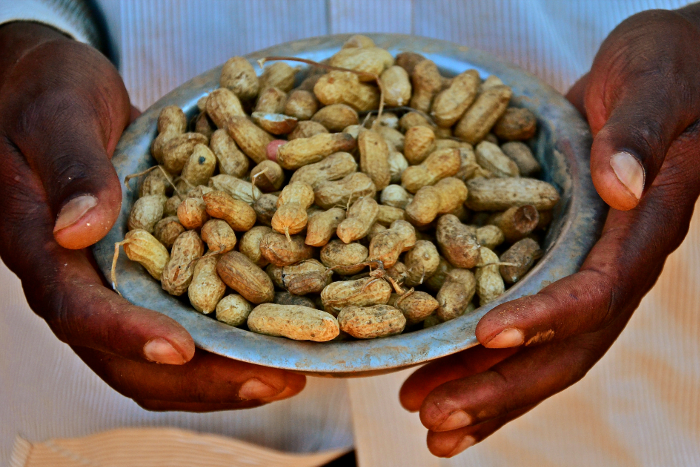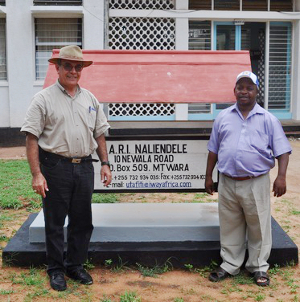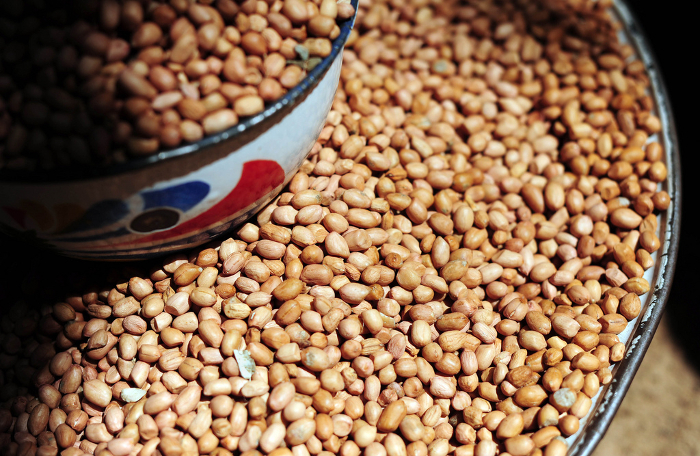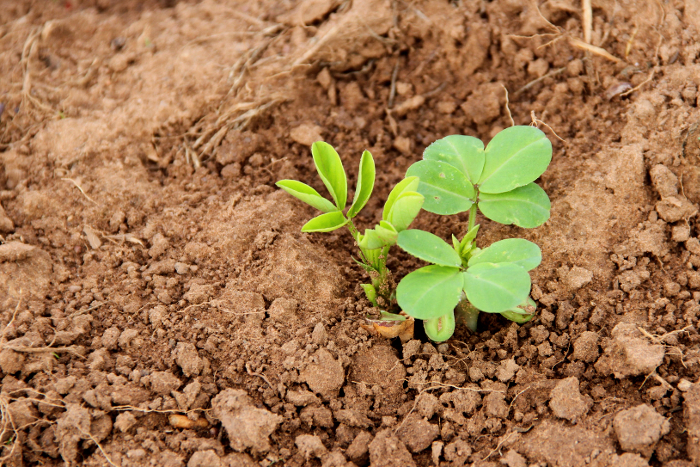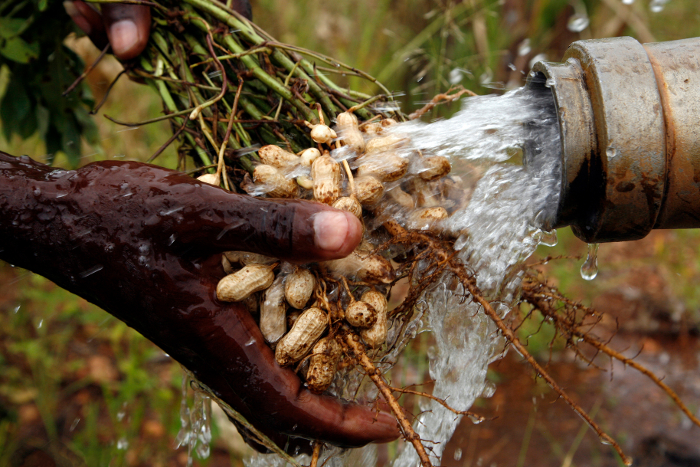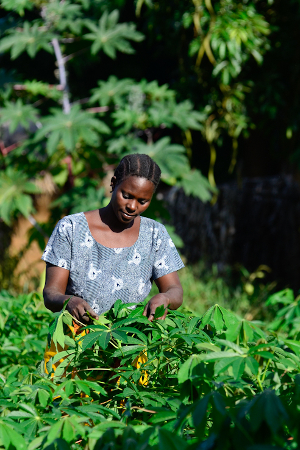
A farmer from Dodoma, Tanzania, an area where climate change is causing increasing heat and drought. Groundnut is an important crop for local famers, forming the basis of their livelihood together with maize and livestock.
If you don’t live with poor people, then your science is of no use to poor people. This is the very clear sentiment of Omari Mponda, one of Tanzania’s top groundnut researchers.
“Sometimes people do rocket science. But that’s not going to help the poor,” says Omari. “Scientists in labs are very good at molecular markers, but markers by themselves will not address the productivity on the ground. You cannot remove poverty through that alone.”
Omari is the Zonal Research Coordinator and plant breeder at Tanzania’s Agricultural Research Institute at Naliendele (ARI–Naliendele).
The passion and dedication of Omari and his colleagues at this East African research centre were the reason why, between 2008 and 2014, the CGIAR Generation Challenge Programme (GCP) provided funding for legumes research at ARI–Naliendele that especially targeted drought, as part of the Tropical Legumes I project. This project supplied national institutes across Africa, Asia and Latin America with training and infrastructure improvements that enabled local researchers to do more advanced plant science that could make a real difference to farmers.
Researchers like Omari, who are working on the ground in developing countries, are a crucial part of the global quest to develop solutions for future food security and improved livelihoods in these countries.
GCP set out to enhance the plant-breeding skills and capacity of researchers in developing nations, such as Tanzania, so that they can develop their own crop varieties that will cope with increasingly extreme drought conditions.
“One thing that really energises me,” enthuses GCP Consultant Hannibal Muhtar, “is seeing people understand why they need to do the work and being given the chance to do the how.”
Hannibal, under his GCP remit, was asked to visit the research sites of GCP-funded projects at research centres and stations across Africa, to identify those where effective research might be hindered by significant gaps in three fundamental areas: infrastructure, equipment and support services. He selected 19 target research sites – in Burkina Faso, Ethiopia, Ghana, Kenya, Mali, Niger, Nigeria and Tanzania.
Two of the locations chosen for some practical empowerment were in Tanzania, namely the ARI research sites at Naliendele and Mtwara, where simple infrastructure improvements like irrigation tubing and portable weather stations have made a surprising difference to the capacity of local researchers.
In developing countries like Tanzania, the obstacles to achieving research objectives are often quite mundane in nature: a faulty weather station, the lack of irrigation systems, or fields ravaged by weeds and in dire need of rehabilitation. Yet such factors compromise brilliant research.
Even a simple lack of fencing commonly results not only in equipment being stolen, but also in precious experimental crops being stomped on by roaming cattle and wild animals such as boars, monkeys, hippopotamuses and hyenas; this also poses a serious threat to the safety of field staff.
“The real challenge lies not in the science, but rather in the real nuts and bolts of getting the work done in local field conditions,” Hannibal explains.
He says: “If GCP had not invested in research support infrastructure and services, then their investment in research would have been in vain. Tools and services must be in place as and when needed, and in good working order. Tractors must be able to plough when they should plough.”
Bridging the gap between the lab and farmers
Since 2008, researchers at ARI–Naliendele in Tanzania have been working together with the International Crops Research Institute for the Semi-Arid Tropics (ICRISAT) to identify suitable groundnut breeding materials to help the country’s farmers improve crop yields. Currently, yields are at less than one-third of their potential.
“We are bridging the big science to the poor people, to see the real issues we should be addressing. You can have a very good resistant variety, but maybe that variety is not liked by farmers,” Omari says.
He recalls a case where one farmer who helped with variety selection for international research had identified a groundnut variety that was resistant to disease, but the shells were too difficult to crack.
“So that variety won’t help the poor, because he [the farmer] is not able to open the shell. So the breeder had to rethink, what trait could loosen, or make it easier to shell?” recounts Omari.
The mission of the 10-year GCP was to use genetic diversity and advanced plant science to improve crops in developing countries. More than 200 partners were involved in the programme, including members of the international CGIAR group plus academia and regional and national research programmes.
National institutes like Tanzania’s ARI–Naliendele, established in 1970, are essential linchpins between advanced research centres in developed countries and poor farmers around the world facing the day-to-day realities of climate change and plant pests and diseases.
“If each organisation works in isolation, they will spend a lot of money developing new varieties but nothing will change on the ground. So in actually working together through programmes like the GCP, we can see some change happening,” says Omari.
Through the GCP project, Tanzania’s groundnut researchers received 300 reference-set lines from ICRISAT, which were then phenotyped over three years (2008–2010) for both drought tolerance and disease resistance in order to select the most useful lines under local conditions. To help with this process, Tanzanian scientists and technicians travelled to ICRISAT headquarters in India, where they were trained in phenotyping: that is, how to identify and measure observable characteristics – in this case, traits relating to the plants’ abilities to cope with drought and disease.
After the researchers identified the best varieties, these were provided to participating farmers so they could trial them in their fields for selection in 2011–2012. Five new varieties have since been released to Tanzanian farmers based on this collaboration between ARI and ICRISAT.
Things are speeding up in Tanzania
For ARI–Naliendele, the laboratory and field infrastructure provided by GCP funding has helped accelerate the work of local researchers and breeders. It has been transformative for Tanzanian scientists, according to Omari.
“For example, irrigation is very costly, but with the GCP support for an irrigation system, we can fast track our work – we can come up with new varieties in a much shorter period. That is something that will change our lives,” says Omari.
“Groundnut has a very low multiplication ratio, so if you plant one kilogram, you will get only 10 kilograms next year,” he explains. “Ten kilograms in 12 months is not enough. With irrigation, it means that we can have at least two or three crops within a season. Some of the varieties we are developing can be fast tracked to the end users. The speed of getting varieties from the research to the farmers has increased by maybe three times.”
GCP also funded computers, measuring scales, laboratory equipment and a portable weather station, which all help to assure good, reliable information on phenotyping.
Scientists too have become quicker and better at their work from having more advanced skills, according to Omari: “We now have more competent groundnut breeders in Tanzania.
“Initially, we depended on germplasm being brought over by ICRISAT and somebody selecting varieties for us. But they have been training us to do our own crosses, so we can now decide what grows in our breeding programme,” he says.
“For us, it is a big achievement to be able to do national crosses. We are advancing toward being a functional breeding programme in Tanzania.
“These gains made are not only sustainable, but also give us independence and autonomy to operate. We developing-country scientists are used to conventional breeding, but we now see the value and the need for adjusting ourselves to understand the use of molecular markers in groundnut breeding.”
Tanzania’s new zest for advanced plant breeding
According to cassava breeder Geoffrey Mkamilo, a Principal Agricultural Research Officer at ARI: “There are some things that you just cannot do by conventional breeding.”
Usually researchers looking to breed better drought-tolerant and disease- and pest-resistant crops would use conventional breeding methods. This means researchers would be trying to pick out resilient plants by phenotyping alone, looking at how they are growing in the field under different conditions, which can take considerable time to deliver results – especially for crops that are slow to mature, like cassava.
Molecular breeding, on the other hand, involves using molecular markers to make the breeding process faster and more effective. These markers are genetic sequences known to be linked to useful genes that confer plant traits such as drought tolerance or disease resistance. Breeders can easily test small amounts of plant material for these markers, so they act like genetic ‘tags’, flagging up whether or not particular genes are present.
This knowledge helps breeders to efficiently select the best parent plants to use in their crosses, and accurately identify which of the progeny have inherited the gene or genes in question without having to grow them all to maturity. Phenotyping is still needed in discovering markers, linking genetic information with physical traits, and in testing the performance of materials in the field, but overall the time taken produce a new variety can be reduced by years.
“Before I started working with GCP, molecular breeding for me was very, very difficult… I wasn’t trained to become a molecular breeder. Now, with GCP, I can speak the same language,” Geoffrey says.
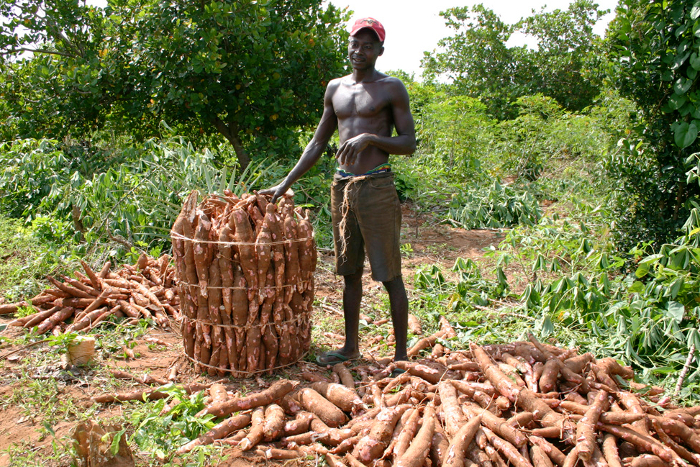
A farmer carefully packs harvested cassava tubers for transportation to the market in Bungu, Tanzania.
Via GCP, Geoffrey had the opportunity to work with scientists based in Colombia at the International Center for Tropical Agriculture (CIAT) and in Nigeria at the International Institute of Tropical Agriculture (IITA), among other experts in research institutes across the world.
The team first began to release new cassava varieties developed using marker-assisted selection in 2011, with four varieties for two different Tanzanian environments. These varieties had manifold benefits: dual resistance to cassava mosaic disease (CMD) and cassava brown streak disease (CBSD), and productivity potential of up to double the yield of existing commercial varieties.
The research continues to produce ever better cassava varieties, and in this endeavour Geoffrey cannot overemphasise the power of integrating conventional breeding practices with molecular breeding.
“I have received so many phone calls from farmers; they even call in the night. They say, ‘Geoffrey, we have heard that you have very good materials. Where do we get these materials?’ So many, many farmers are calling,” says Geoffrey. “Many, many organisations – even NGOs, they also call. They want these materials. And even the private sector calls. GCP has contributed tremendously to this.”
More links
- Here on the Sunset Blog: groundnut | cassava | capacity building
- GCP blogposts: groundnut | cassava | capacity building
- Presentations on Slideshare: groundnut | cassava
- Videos on YouTube: groundnut | cassava
- Legumes Research Initiative | InfoCentre
- Cassava Research Initiative | InfoCentre








